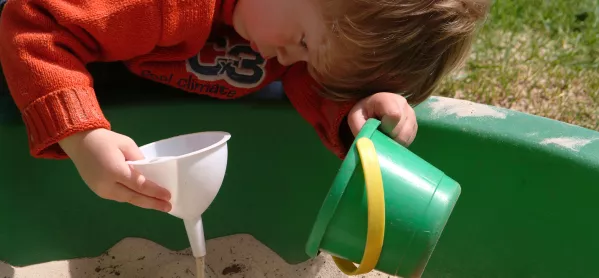- Home
- EYFS: In praise of the humble sandpit
EYFS: In praise of the humble sandpit

If you were to ask me what my most favourite outdoor play resource is I would say sand. Every time.
It’s something I have given a lot of thought to recently. In my school we have been asked to consider some adaptations to our sand provision. For me and my team we found the idea of limiting sand-play almost impossible to consider.
Quick read: Meet Claudia: a scared NQT already making a difference
Quick listen: Why we need more support for mental health in primary
From the magazine: After-school clubs need care and attention
We are fortunate to have an amazing sandpit, mostly due to its mighty size! The children absolutely love it and so it offers huge potential for learning. While we were easily able to justify the benefits of our sand play, the discussion has been interesting because it has made us reflect: “What makes good quality sand play provision?”
I love to watch children playing in the sand. For me it perfectly illustrates the key messages in the poem The 100 Languages of Children by Reggio Emilia. It is the most versatile learning resource for children to creatively explore, investigate and experiment making the possibilities for learning almost endless.
We must remember that this type of rich play and learning do not just happen, it is not simply a case of plonking a plastic tray outdoors. I believe that the quality of sand-play provision is really determined by careful planning of your sand position, size and resources.
Beach vibes
Whenever I watch children at the beach, I notice that innate fascination that all children have with sand. It is this element of the “beach” that we do aim to capture with our sand provision.
At my school the sandpit became a big project a few years ago. The team really spent time researching the best way of providing sand play, and carefully planned the space. The purpose-built sandpit was positioned in the centre of the garden, and most importantly at ground level.
A ground-level “beach style” sandpit really does offer that much more, so if you are feeling inspired, I would definitely recommend this. It can be put together on a budget with some help from parents to provide a fantastic learning space for the children.
The bigger the better
So why is size important? The much larger space does benefit the range of play on many levels. It allows children to fully explore concepts such as length, height and capacity.
If we take the example of learning about capacity, the advantage of being outdoors in a large space is clear. Children cannot learn about capacity in a small shallow container. In a larger area, the sand can be filled to a really deep level offering children adequate space to dig and to fully explore the concept.
On reflection, we have also noticed that bigger sand pits are most important for physical development because they offer “real” digging opportunities. When children use long-handled tools, they stand and engage their full bodies, enabling them to build shoulder stability and muscle strength which are so important for writing.
The children can also practise a range of other physical skills - such as jumping and balancing. They are able to take risks as the sand is perfect for offering an impact absorbing surface.
There is also the advantage of being able to accommodate a much bigger group of children at a time, promoting collaborative play. In contrast, when children are crowded around a small plastic tray, it often results in so many conflicts.
Because the sandpit is a wide, open space and positioned centrally in the garden we see such an inspiring range of creativity in our children’s play. They enjoy linking up small world creatures, natural materials, vehicles, planks, tubes, channelling, and containers. Children never fail to surprise us with new ideas and combinations that are added to the space.
There are a wide variety of skills to be developed: digging, balancing, measuring, counting, building, mixing to name a few.
Managing the challenges
So, there are admittedly a few challenges to providing this wonderful experience for the children but they are not insurmountable. Here are some of the practical ways we maintain the space that are worth bearing in mind, whatever your level of sandpit provision.
- Always have brooms handy. The children can be encouraged to help to sweep the sand back.
- Remember to use a cover every time - we use a large tarpaulin weighed down with tyres.
- Check daily for cats/foxes faeces. If needed you can flush the sand with large buckets sterilised water (sterilising tablets work well).
- Top sand up regularly to ensure that is doesn’t get too low. Bulk buy and children can help to fill with buckets and wheelbarrows.
-
Consider adding some shade. This can also offer a physical structure to hang bucket pulleys, which are always a hit!
Helen Pinnington is early years foundation lead at St Thomas More’s Catholic Primary School in Bedhampton, Hampshire
Keep reading for just £1 per month
You've reached your limit of free articles this month. Subscribe for £1 per month for three months and get:
- Unlimited access to all Tes magazine content
- Exclusive subscriber-only stories
- Award-winning email newsletters



